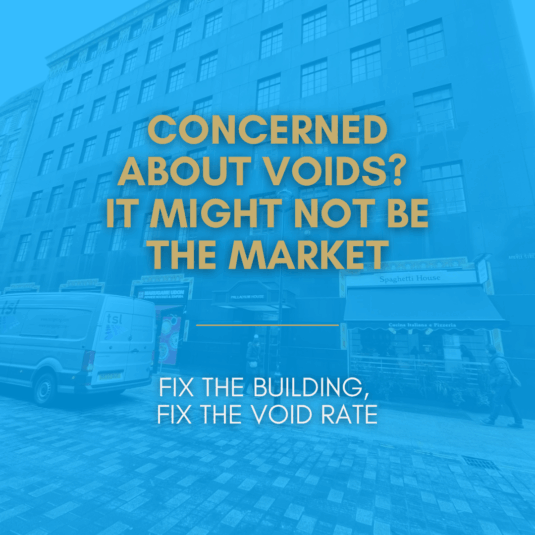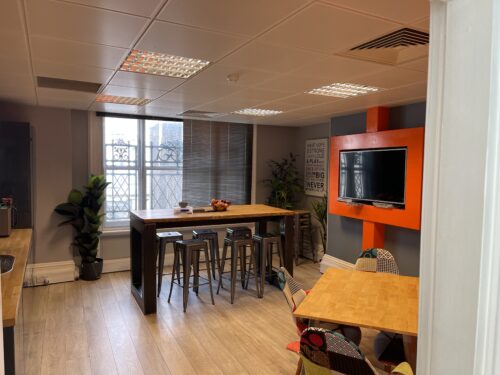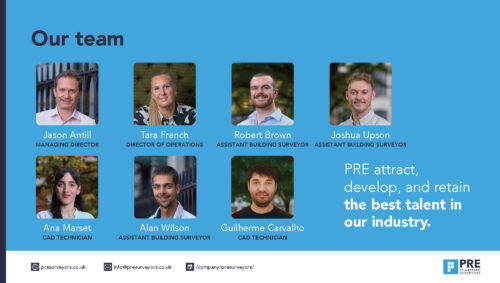News
How to Reposition Your Building to Reduce Void Rates & Minimise Lease Renegotiations

Across the UK commercial property market, many landlords and asset managers are facing increasingly familiar challenges:
📉 Prolonged void periods
🔁 More break notices
❌ Tenants choosing not to renew
⚠️ Rising pressure to meet intensifying ESG and EPC standards
With new EPC regulations requiring commercial properties to meet a minimum rating of C by April 2027 and B by 2030 for new leases, we’re witnessing a clear flight to quality. Companies are becoming more selective, actively seeking spaces that not only meet today’s standards but also future proof their operations against upcoming regulatory and ESG requirements.
While these trends are often linked to wider economic uncertainty, they’re just as often a reflection of something more fundamental – that the building itself may no longer meet market expectations.
In last month’s roundtable, we discussed how tenant expectations have shifted, in both commercial and residential settings. From hospitality-style experiences to flexibility and sustainability, there’s a growing demand for spaces that offer more than just square footage.
This month, we’re digging into how proactive project management can help reposition underperforming buildings, future proofing them for the modern market.
The Market in 2025: Efficiency, Flexibility and ESG
Commercial leasing has changed. Since the pandemic, hybrid working, operational efficiency, and ESG have risen to the top of the occupier agenda.
As a result:
- Many occupiers are downsizing
- Building quality and energy performance are deal-breakers
- Tenants are using lease events as opportunities to reset, not just renegotiate
This has created a clear split in the market:
- High-performing, well-located, energy-efficient buildings are letting- though deals may take longer to complete
- Secondary stock in less prominent locations, with dated services and a poor EPC, is being left behind
The 4 Most Common Reasons Why Tenants Are Walking and What Can be Done About it
- Poor EPC Performance
Many corporate occupiers – particularly those with strict net zero targets – are already excluding anything rated below a B from their property searches, due to the impending regulation changes.
We’ve worked on buildings still running at EPC D or E, often due to outdated or undocumented M&E systems. These buildings are regularly being filtered out of searches before they even make it to the viewing stage.
Our Tip: If your building’s EPC hasn’t been reviewed post-pandemic, now’s the time to reassess and make the necessary changes needed.
- The Space No Longer Works for How People Work
Fixed layouts. Lack of breakout areas. Poor lighting. These are all red flags for modern occupiers who now expect space that can support a mix of focused, collaborative, and flexible working styles.
As we explored in last month’s blog, commercial occupiers – much like residential renters – increasingly want a more service-led, hospitality-style experience.
Buildings that don’t enable this are being left behind.

- First Impressions Matter
Reception areas, WCs, signage, and lobbies may seem like minor details, but for prospective tenants, they’re a window into the landlord’s intent.
We’ve seen significant uplift in viewings and lease interest just from simple refurbishments, including:
- Reconfigured receptions
- Improved lighting and finishes
- Refreshed WC facilities
- More prominent signage and wayfinding
These don’t require huge capex, but they do require attention to detail and a clear strategy.
- Inefficient or Obsolete Building Services
No one wants to have to deal with oversized HVAC systems, poor zoning, or energy-wasting plant rooms, especially when paying fixed service charges.
In 2025, even smaller occupiers are scrutinising operational costs and ESG risk. Replacing or upgrading services might not be flashy, but it often delivers the most measurable return in terms of:
- Reduced energy bills
- Improved tenant satisfaction
- Higher EPC ratings
- Lower void risk
How We Can Help You Reposition Strategically
At PRE, we work with landlords and investors to unlock the value in underperforming commercial buildings. We’ve helped reposition assets across the UK through:
- Technical Assessments and Void Diagnostics
- Measured surveys and EPC risk analysis
- M&E condition assessments
- Dilapidations and compliance audits
- Costed schedules of work
- Feasibility and Refurbishment Planning
- Tailored to budget, lease timing and target tenants
- Phased upgrade strategies
- EPC improvements by floor
- CAT A+ plug-and-play solutions
- Common part and WC refurbishments
- Project Delivery and Contract Administration
- Full design and procurement
- Contractor selection and cost control
- Statutory approvals
- On-site project management
📍 Case Study: Take a look at how we helped reposition Palladium House
Final Thought: Every Lease Event Is an Opportunity
It’s easy to see lease breaks or void periods as a negative, but often, they’re your most valuable opportunity to reset the strategy, upgrade an asset, and futureproof your income stream.
With the right surveying and project team in place, these moments become stepping stones – not setbacks.
Let’s Talk
📩 Ready to unlock your asset’s full potential? Get in touch to arrange a site visit or schedule a call with our team.
